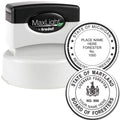If you’ve ever stamped piles of paperwork only to run out of ink at the worst possible moment, you know how frustrating it can be to juggle multiple stamp pads. A self inking inspection stamp simplifies that workflow, keeping the ink neatly inside the device so you can quickly mark documents, containers, or packages without any fuss. Whether you need a dependable quality-control mark or a date stamp for time-sensitive items, the right features in your inspection stamp will save you headaches in the long run. In this guide, you’ll learn how to spot the key characteristics that make your stamping smoother, more consistent, and even a little more fun.
Understand Self Inking Stamps
A self inking stamp, as the name suggests, houses its own ink pad in a handy compartment. Each time you press down, the stamp face flips internally, re-inks, and then leaves a crisp impression on the surface. This mechanism is different from a pre-inked stamp, which carries ink soaked into the rubber or polymer material. From marking “QC Approved” to logging a custom inspection design, self inking tools are popular for their blend of speed and tidiness.
How They Compare to Traditional Stamps
- Traditional rubber stamps need a separate ink pad, which can take up more desk space and time.
- Self inking models are an all-in-one solution that keeps ink accessible yet contained.
- Self inking inspection stamps typically offer sharper prints for repeated use, maintaining consistency day in and day out.
If you’re new to inspection stamps or simply want an upgrade, grasping this basic difference will help you pick a product that suits your workflow and environment.
Check Durability And Quality
When you’re inspecting hundreds of items a day, the construction of your inspection stamp matters. You need something that stands up to repeated presses without jamming or degrading.
Materials And Build
- Heavy-duty plastic frames balance weight and ruggedness.
- Metal frames are sturdier but can be heavier to handle.
The housing around the stamping mechanism should feel firm in your hand. Loose or flimsy parts can cause alignment issues, leading to a crooked impression or splattered ink. Also, look for protective covers over the ink pad area to prevent dust buildup and accidental smudges.
Why Durability Is Essential
Durability isn’t just a “nice to have.” If you rely on a custom inspection stamp for labeling QC or QA checks, a broken device can throw off your entire process. High-quality stamps:
- Stay aligned for consistent impressions.
- Resist cracks or breaks if dropped.
- Carry re-inkable pads that maintain reliable operation over time.
Take ESS, for example. We’re a family-owned business, operating since 1964, and we understand the importance of a strong, long-lasting stamp. Our commitment to quality and fast turnaround has made us a top-notch supplier for all kinds of inspection, QA, and QC stamps. That means you can count on a stamp that holds up through the usual wear and tear of daily business.
Consider Ink Capacity And Colors
Imagine you’re halfway through a production run when your stamp’s ink starts fading out. That faded “Approved” might raise unnecessary questions or cause confusion. Ink capacity is crucial, especially if you’re stamping multiple items in quick succession.
Choosing the Right Ink Capacity
- Standard ink pads can usually cover several thousand impressions before needing a refill.
- High-capacity cartridges are available for those who process massive volumes.
- Some self inking models allow you to pop out the ink pad and flip it, doubling the pad’s life between refills.
No matter which route you choose, be prepared with extra refill cartridges if your workload is heavy. Running out of ink mid-shift isn’t fun, and having spares ensures you stay on schedule.
Exploring Ink Colors
Inspection stamps often need more than the typical black.
- Red ink is popular for warnings or urgent notices.
- Blue ink stands out on paperwork where black text is standard.
- Specialty colors like green or purple can add a unique visual cue.
You’ll also want to consider whether your documents or surfaces have any color constraints, such as dark backgrounds that require brighter, more opaque ink. A well-chosen color sets your mark apart, helping workers and inspectors spot that crucial label the moment they see it.
Evaluate Impression Clarity
If the details on your stamp are blurry, you might as well not stamp at all. From verifying batch numbers to logging compliance codes, clarity is everything. Crisp lines and easy-to-read text lower the risk of error and prevent confusion in busy environments.
Tips for Achieving the Best Imprint
- Keep surfaces clean and free of dust or moisture.
- Test a new ink pad a few times on scrap paper before using it on official documents.
- Reapply gentle, consistent pressure, rather than slamming the stamp down.
Also, check how the stamp’s rubber or polymer face is etched. A well-etched stamp face with fine lettering ensures the design prints exactly as intended.
Factor In Stamp Size And Shape
It might sound obvious, but if your stamp is too large, it may not fit the space you have to mark. If it’s too small, your imprint could be overlooked. Getting the right dimensions saves you from awkward alignment issues and helps keep your labeling professional.
Finding the Right Dimensions
- Measure the area on forms, boxes, or labels where you plan to stamp.
- Account for any text or branding that needs to fit within the design.
- Remember that more text typically requires more space for readability.
Some people prefer a round or oval shape for inspection stamps because they fit well in tighter corners and look visually distinct. Others find rectangle or square stamps more versatile, with room for a company name, date, and unique identifier. Ultimately, it depends on your content and how prominently you need to display it.
Look For Ergonomic Designs
Stamping hundreds of items a day can get tiring. Even a small difference in handle shape or grip texture can improve comfort, reduce hand fatigue, and help you move faster through your tasks.
Ergonomic Considerations
- Contoured grips: Look for stamps with molded handles that let you grasp the tool with minimal strain.
- Lever or push-button style: Some models have a button-based design that requires less downward force.
- Smooth operation: A stamp that glides up and down reduces repetitive stress.
It’s not just about feeling comfortable in the moment, either. Proper ergonomics can help lessen the risk of repetitive strain injuries, which can be a concern in high-volume stamping scenarios.
Explore Custom Logo Options
Consistency in branding goes beyond your website or signage. If you’re marking paperwork, packaging, or product labels, a sleek custom stamp featuring your logo can leave a memorable impression. You can integrate text with your logo to confirm product quality or pass an inspection.
Why Brand Consistency Matters
In a world where customers and auditors pay close attention to detail, a uniform look projects professionalism and reliability. Whether you require a small mark in the corner of quality documents or a bold, central logo, a custom approach can highlight your brand’s commitment to thorough inspections.
For instance, if you’re considering adding your emblem to your inspection stamp, take a look at our company logo inspection stamp. It’s a simple way to keep all your QC materials looking sharp and on-brand, whether you’re stamping cartons or internal documents.
Summarize Key Benefits
At this point, you might be wondering how to juggle the many factors: durability, ink capacity, sizing, and more. To make it simpler, here’s a quick rundown of why investing in a top-quality, self inking inspection stamp pays off:
- Reliable Durability: Built to handle frequent marking without breakdown.
- Convenient Ink System: Thousands of impressions before needing a refill, in colors that suit your needs.
- Clear Impressions: Crisp lines that ensure easy reading in busy workplaces.
- Tailored Dimensions: A suitable shape and size for your specific documentation space.
- Comfortable Use: Ergonomic design lets you stamp away without stressing your hand.
- Branding Power: Show off your company logo and maintain professionalism across all your labels.
And, of course, an excellent supplier can make or break your experience. At ESS, we pride ourselves on our fast turnaround times and dedicated support. Because we’re family owned and operated since 1964, we appreciate the trust customers place in our products and service. We want you to feel confident when you pick up that stamp each morning.
Wrap Up Your Choice
Choosing the right inspection stamp might seem complicated, but remember this: you’re not just buying a tool, you’re investing in a workflow solution. A well-designed, self inking device prevents smudges, speeds up approvals, and helps you create a clean, professional impression every time you mark a form or product.
If you need help figuring out the best setup, consider jotting down your typical usage scenarios: the amount of stamping, common surfaces, and any unique branding needs. By pairing your insights with the features outlined above, you’ll streamline your inspection process in no time.
Frequently Asked Questions (FAQs)
1. Can I Refill A Self Inking Inspection Stamp?
Absolutely. Most self inking devices are designed for easy refill. You can replace or re-ink the pad itself. When the print starts fading, a quick refill or pad swap will usually bring it back to its original vibrancy.
2. Which Ink Color Is Ideal For Quality Control?
Black ink is the go-to choice for general office documents, but red or blue can stand out more in quality-control or inspection contexts. It really depends on your preference and the types of items you’re labeling. Some businesses even have multiple stamps in different colors for quick visual cues.
3. Do Customized Stamps Take Longer To Produce?
At ESS, we pride ourselves on a very fast turnaround, even for custom orders that include logos or specialized text. Production times vary by complexity, but we do our best to get your custom stamp to you as quickly as possible. Being family owned and operated since 1964, we know how much speed and reliability matter.
4. How Do I Maintain Impression Clarity Over Time?
Keep your stamp away from dust or excess moisture, and store it in a stable environment when not in use. If you notice fading or uneven prints, simply refill the ink pad or replace it. Also, give the rubber surface a quick wipe periodically to remove any buildup.
5. What Size Stamp Do I Really Need?
That depends on what you’re stamping. If you need multiple lines of text or a large logo, choose a bigger imprint area. If your stamp only needs a short QC or date message, a small model could be enough and easier to use on tight forms. Always measure your typical stamp section beforehand to ensure a good fit.
Feel free to reach out to our team at ESS for more guidance, so you can find exactly the right features for your self inking inspection stamp. Whatever your stamping needs, a well-chosen device is an investment in smooth, stress-free operations for every single inspection. Happy stamping!


















